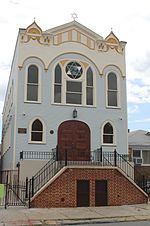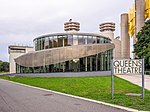Flushing Meadows Carousel

The Flushing Meadows Carousel is a carousel located in Flushing Meadows-Corona Park in the New York City borough of Queens. It contains four rows of figures, including 64 jumping horses, 7 standing horses, 1 menagerie animal (a lion), and 2 chariots. It was created to serve patrons of the 1964 New York World's Fair by combining two earlier carousels, both of which were carved in Coney Island in the first decade of the twentieth century by renowned carver Marcus Illions. During the fair, it stood on a nearby site within the park, and it was moved to its present site in 1968, where it has remained in service ever since.In 2016 it was listed on the National Register of Historic Places.
Excerpt from the Wikipedia article Flushing Meadows Carousel (License: CC BY-SA 3.0, Authors, Images).Flushing Meadows Carousel
United Nations Avenue South, New York Queens
Geographical coordinates (GPS) Address Nearby Places Show on map
Geographical coordinates (GPS)
| Latitude | Longitude |
|---|---|
| N 40.743055555556 ° | E -73.849166666667 ° |
Address
Feltman Carousel
United Nations Avenue South 16
11368 New York, Queens
New York, United States
Open on Google Maps











